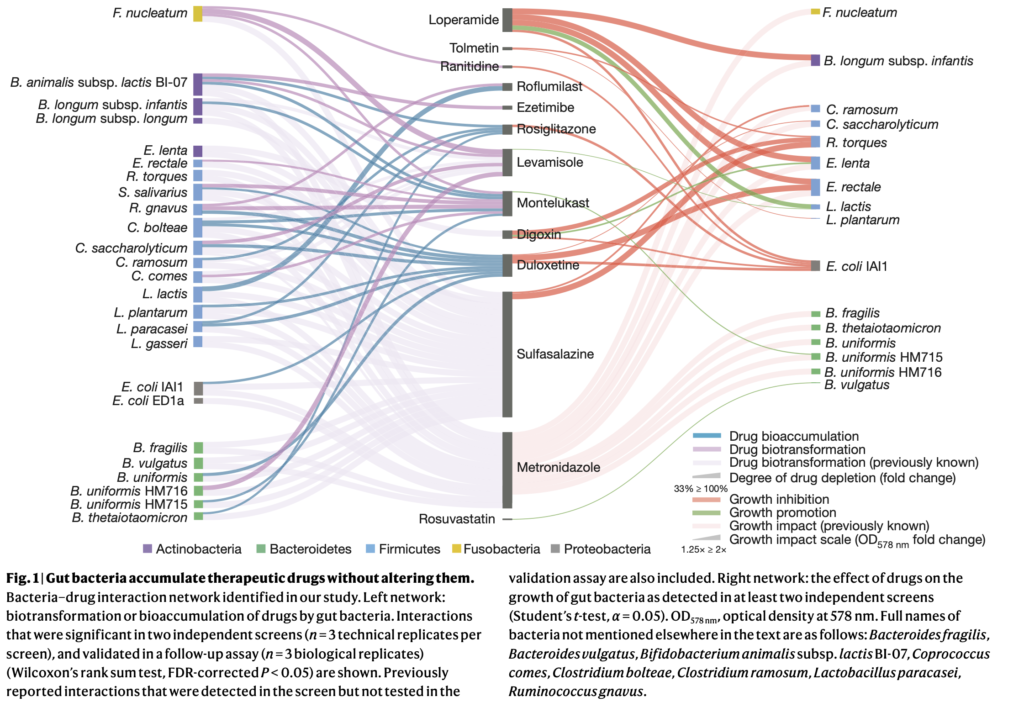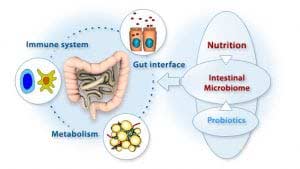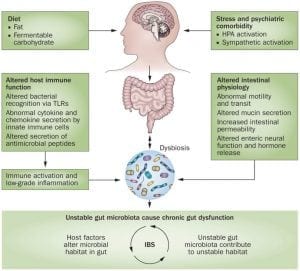Category: gut microbiome
Medication Accumulation in Gut Bacteria May Curb Drug Effectiveness, Alter Gut Microbiome
October 05, 2021 2:06 pm
 “As the authors note,” she said, “this study in bacterial isolates is only the first step towards understanding how bioaccumulation might influence drug metabolism and microbial community composition in the context of the far more complicated communities of microbes in the human body.”
“As the authors note,” she said, “this study in bacterial isolates is only the first step towards understanding how bioaccumulation might influence drug metabolism and microbial community composition in the context of the far more complicated communities of microbes in the human body.”
Gut Biome and Body Fat
October 06, 2016 7:02 am
The Gut Biome and body fat link continues to be an interesting and new front in the science of obesity. Although we know more factors in obesity it has remained an elusive multi-factorial process. The following article is yet another piece of the puzzle.
Study finds link between faecal bacteria and body fat “Researchers at King’s College London have found a new link between the diversity of bacteria in human poo – known as the human faecal microbiome – and levels of abdominal body fat.
The research, published today in Genome Biology, also provides further evidence of possible genetic influences on obesity, through heritable bacteria found in the faecal microbiome.”
View the rest of the article here. The research paper here.
Our past posts on gut biome and probiotics here
Probiotics and Prebiotics
May 26, 2016 1:59 pm
Probiotics and Prebiotics are an important part of our overall general and gastrointestinal health. The gastrointestinal (GI) tract is a large, muscular tube that allows the digestion of food. The intestinal lining of the tract plays a role in absorbing vital nutrients and acts as a barrier for the macromolecules and microorganism from circulation. Our GI system is exposed to many bacterial agents that undergo fermentation in the mucosa. The type of fermentation carried out in the gut is greatly influenced by the types of bacteria found in the lumen.
The GI microflora is an elaborate ecosystem consisting of neutral and beneficial bacteria whose balance impacts overall health. This microenvironment consists of about 400 different bacterial species that make up approximately 100 billion organisms in the gut. The flora functions in nutrient consumption, vitamin production, detoxification, hormone activity, and other regulatory processes. Abnormal microbial balance or colonization results in dysbiosis, where the deviant nature of bacteria may become pathological (7). Dysbiosis is a contributing factor to many degenerative and chronic diseases.
Benefits of Probiotics and Prebiotics:
Our bodies are full of both good and bad bacteria. Probiotics contain live bacteria and yeasts, whose activity is beneficial when present in appropriate amounts (11,12). These helpful microorganisms regulate the body’s systems in several ways:
- Gastrointestinal: Probiotics work to reduce infectious diarrhea, specifically types identified by antibiotic use (1). Certain strains enhance stool consistency and bowel movement frequency. Probiotics have also proven effective in alleviating bloating and gas found in irritable bowel syndrome (9). Further studies suggest that specialized strains aid in milder forms of ulcerative colitis, an inflammatory bowel disease. A recent Russian study suggested eradication of SIBO and IBS using a combination of Bifidobacterium bifidum, Bifidobacterium longum, Bifidobacterium infantis and Lactobacillus rhamnosus, called Florasan-D available in Russia. These findings were presented at the 2015 Gut Microbiota for Health World Summit in Barcelona, Spain by Elena Polouektova, MD, a researcher at I.M. Sechenov First Moscow State Medical University.
- Weight Loss: A clinical study (8) revealed reduced body fat in patients who consumed yogurt (probiotic source), although there were no observed changes in weight. Another study, published in the 2011 European Journal of Clinical Nutrition (6), found that subjects who consumed fermented milk that contained a specific bacterial strain observed abdominal fat and weight loss, when compared to subjects drinking a control.
- Immunity: Although the clinical implications of this evidence are still being studied, it has been found that immune response strength is greatly improved through certain strains of probiotics (2,4). They have also been shown to lighten hypersensitivity reactions and normalize added mucosal dysfunction.
- Other Uses: Bacteria also reside in the mouth. Probiotics play an essential role in oral health, where they reduce throat infection, bad breath and periodontal disease, a gum infection (5). There have been claims that probiotics lower the effects of some skin conditions, prevent colon cancer, lower blood pressure and cholesterol, and alleviate anxiety and depression (3). Future studies are working towards the consistency of these claims.
Probiotics regulate the movement of food through the digestive system. They help replace unwanted bacteria and maintain the mucosal microenvironment to avoid dysfunction. Prebiotics are fiber compounds that move through the GI tract undigested. Prebiotics are important in stimulating probiotic growth and maintaining a stable environment for their optimal activity (13). The best way to get all the powerful benefits of probiotics is through consuming foods that are prepared by bacterial fermentation. Supplements are also available. Previous blog regarding probiotic supplements here. Previous blog regarding probiotics, C.Diff and Hyperoxaluria here.
Written by: Mariam Michelle Gyulnazaryan & Dr. Ara Keshishian
References
- Bowen, J. M., Stringer, A. M., Gibson, R. J., Yeoh, A. S., Hannam, S., & Keefe, D. M. (2007). VSL# 3 probiotic treatment reduces chemotherapy-induced diarrhoea and weight loss. Cancer biology & therapy, 6(9), 1445-1450.
- Chiang, B. L., Sheih, Y. H., Wang, L. H., Liao, C. K., & Gill, H. S. (2000). Enhancing immunity by dietary consumption of a probiotic lactic acid bacterium (Bifidobacterium lactis HN019): optimization and definition of cellular immune responses. European journal of clinical nutrition, 54(11), 849-855.
- Foster, J. A., & Neufeld, K. A. M. (2013). Gut–brain axis: how the microbiome influences anxiety and depression. Trends in neurosciences, 36(5), 305-312.
- Isolauri, E., Sütas, Y., Kankaanpää, P., Arvilommi, H., & Salminen, S. (2001). Probiotics: effects on immunity. The American journal of clinical nutrition, 73(2), 444s-450s.
- Krasse, P., Carlsson, B., Dahl, C., Paulsson, A., Nilsson, A., & Sinkiewicz, G. (2005). Decreased gum bleeding and reduced gingivitis by the probiotic Lactobacillus reuteri. Swedish dental journal, 30(2), 55-60.
- Merenstein, D., Murphy, M., Fokar, A., Hernandez, R. K., Park, H., Nsouli, H., … & Shara, N. M. (2010). Use of a fermented dairy probiotic drink containing Lactobacillus casei (DN-114 001) to decrease the rate of illness in kids: the DRINK study A patient-oriented, double-blind, cluster-randomized, placebo-controlled, clinical trial. European journal of clinical nutrition, 64(7), 669-677.
- Myers, S. P. (2004). The causes of intestinal dysbiosis: a review. Altern Med Rev, 9(2), 180-197.
- Omar, J. M., Chan, Y. M., Jones, M. L., Prakash, S., & Jones, P. J. (2013). Lactobacillus fermentum and Lactobacillus amylovorus as probiotics alter body adiposity and gut microflora in healthy persons. Journal of functional foods, 5(1), 116-123.
- Prantera, C., & Scribano, M. L. (2009). Antibiotics and probiotics in inflammatory bowel disease: why, when, and how. Current opinion in gastroenterology, 25(4), 329-333.
- Reid, G., Jass, J., Sebulsky, M. T., & McCormick, J. K. (2003). Potential uses of probiotics in clinical practice. CLINICAL microbiology Reviews, 16(4), 658-672.
- Rolfe, R. D. (2000). The role of probiotic cultures in the control of gastrointestinal health. The Journal of nutrition, 130(2), 396S-402S.
- Sanders, M. E. (2008). Probiotics: definition, sources, selection, and uses. Clinical Infectious Diseases, 46(Supplement 2), S58-S61.
- Schrezenmeir, J., & de Vrese, M. (2001). Probiotics, prebiotics, and synbiotics—approaching a definition. The American journal of clinical nutrition, 73(2), 361s-364s.



